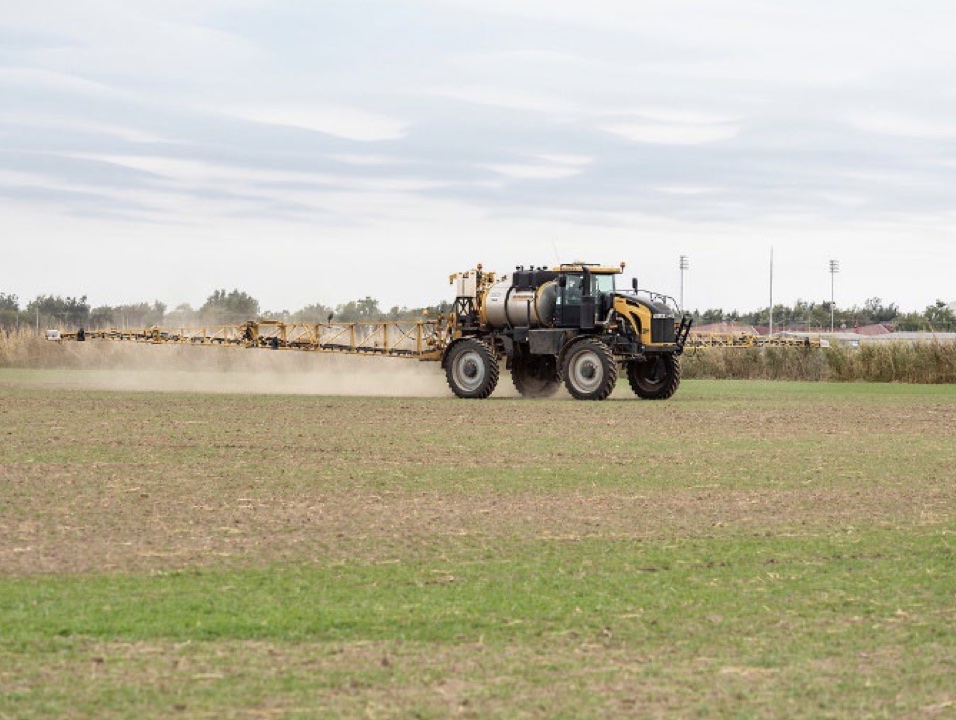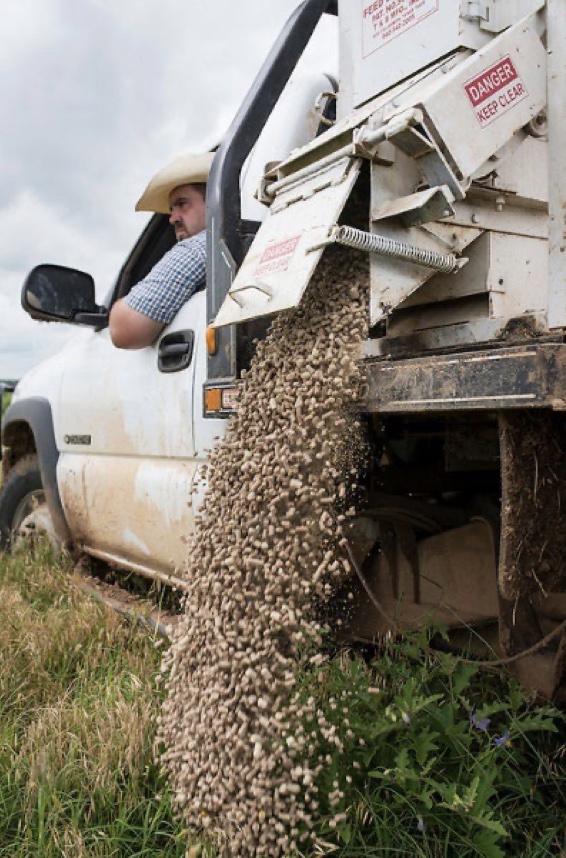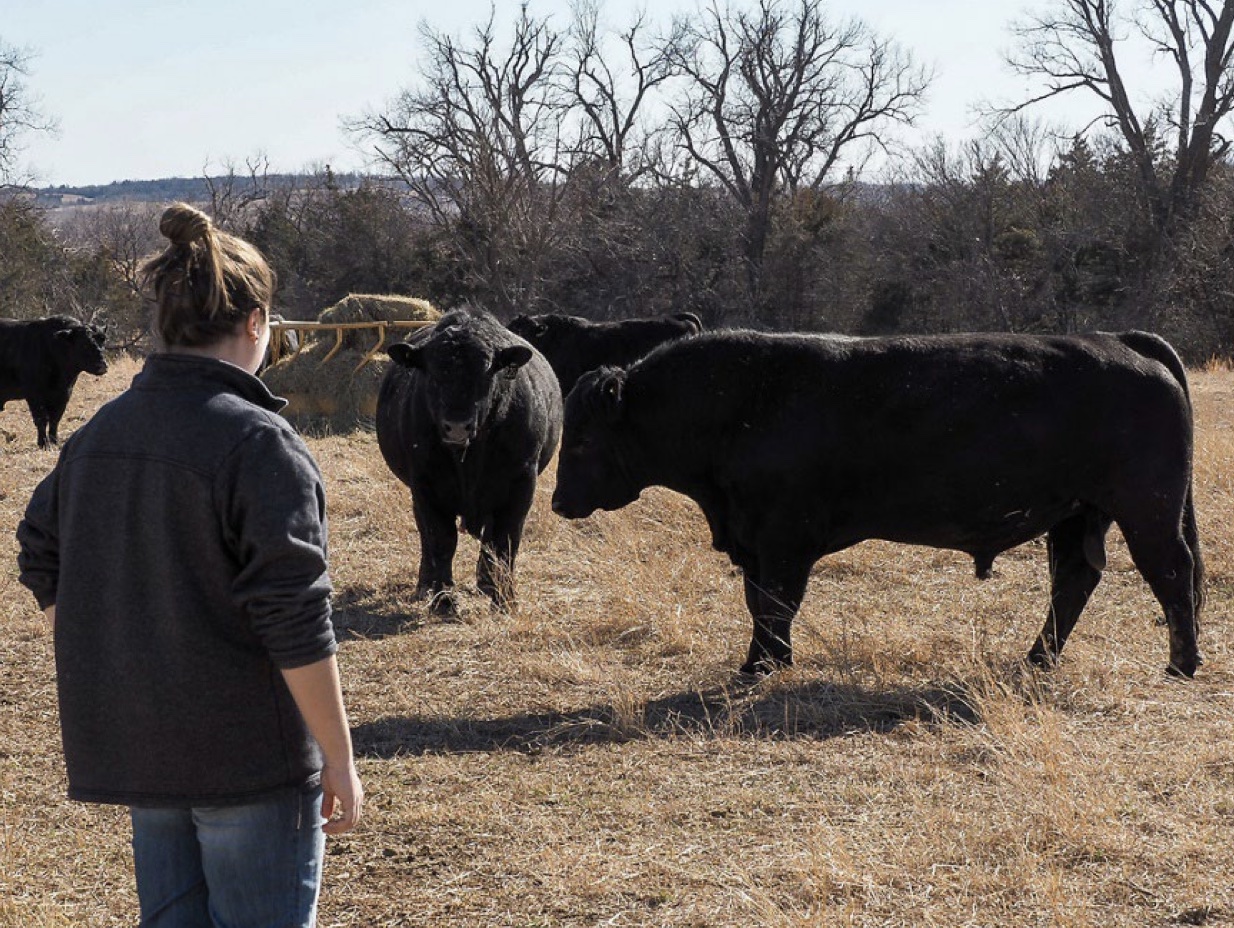Ag Insights December 2023
Friday, December 1, 2023
Winter and Spring Management in Wheat
Josh Bushong, West Area Extension Crops Specialist
 Now that we had a week of good growing conditions after some timely rains, the early
sown wheat is finally taking off and growing quick. In addition to the crop, the weeds
are also starting to get established as well. Late fall and winter herbicide applications
can be very beneficial to manage our difficult to control winter annual grassy weeds,
especially if you are going after a grain crop.
Now that we had a week of good growing conditions after some timely rains, the early
sown wheat is finally taking off and growing quick. In addition to the crop, the weeds
are also starting to get established as well. Late fall and winter herbicide applications
can be very beneficial to manage our difficult to control winter annual grassy weeds,
especially if you are going after a grain crop.
Budgeting a fall or winter herbicide application is beneficial because weeds that are small are much easier to control. A few great examples that farmers might consider applying a herbicide right now include rescuegrass, feral rye, and jointed goatgrass. If farmers wait till spring after these weeds are winter hardened and well tillered, herbicide control will be expected to be reduced.
If a farmer is using one of the two herbicide-tolerant wheat systems, i.e. Clearfield or CoAxium, and is prioritizing weed management this year, a sequential fall followed by a spring herbicide application is our best management recommendation.
There are a couple of concerns when debating on a fall or winter herbicide application. These include weed control, crop injury, and delayed weed emergence. If the weeds are not actively growing, herbicide efficacy will be reduced because the plant is going dormant, and the herbicide won’t get into the plant. If waiting till spring to avoid delayed emergence of weeds, keep in mind the weeds that impact crop yields the most are the ones that came up with the crop. The best return on investment is almost always the earlier application.
Crop safety is occasionally an issue as well. Ideally, a herbicide application should be applied when there are a few days before and after with temperatures exceeding 60 degrees. Consult the herbicide label to find specific recommendations for the products you will apply. While rare, I’ve even seen Finesse and Axial products injure wheat when applied around a freeze event.
Delayed emergence from drought and now cold soil temperatures can have an impact on potential grain yields. Wheat only needs at least 4-5 leaves and 1-2 tillers prior to dormancy. In the fields I’ve been in most wheat plants are setting a second tiller. Hopefully more leaves and secondary roots will develop before dormancy truly sets in. Instead of making plans for heavy topdress nitrogen applications this winter or even early spring, it might be wise to wait later into the spring to better estimate grain yield potential.
As far as how late wheat can be topdressed with nitrogen, field research conducted by OSU the past four seasons has shown it might be later than your think. These grain only trials have proven that topdress applications made 80-100 growing degree days after planting, typically early to mid-March, overwhelmingly yielded the same as early and late winter applications. Wheat quality, particularly grain protein, seemed to increase with later nitrogen applications as well.
This doesn’t mean to wait till the last minute to topdress, but this supports extending the window to apply nitrogen. Applying later in the season can increase nitrogen use efficiency. As the crop progresses, a better estimation of grain yield can be more accurately determined and topdress rates can be altered accordingly. If covering large acreage, wheat producers should initiate topdress applications sooner to allow enough time to get the job done especially if weather delays application.
Topdressing tank-mixed with a herbicide can be an economical option. Since the sprayer will be using a broadcast nozzle, such as a flat fan, Urea Ammonium Nitrate (UAN) rates should be limited to 10 to 20 gallons per acre depending on conditions. Applications should be avoided when air temperatures rise above 70° and relative humidity is low. Applications should be made prior to jointing stage, which will limit yield loss by allowing more recovery time if crop injury occurs.
Disease management has shown to have good yield savings over the years. If applied timely, most commercially available fungicides have had good yield protection in OSU field trials. If only one application is budgeted, it is best to apply late and protect the flag leaf. Long-term OSU data typically average about 10 to 20 percent higher yield compared to no fungicide.
Timely field scouting is the only way to determine if a pest is present and if an application of an herbicide, insecticide, or fungicide is warranted. The only way for one of these pesticides to protect yield and have a positive return on investment would be knowing what pests are present and knowing how much yield potential can be saved if applied correctly.
What Hay Feeder Do You Use?
Dana Zook, West Area Extension Livestock Specialist
 Have you ever wondered if there was a way to make your cattle operation more efficient?
Feed cost is one of the greatest variables impacting cattle producers accounting for
40-70% of total cow cost. The winter-feeding season is a great time to address feeding
accuracy and efficiency. Luckily, OSU Extension is offering several opportunities
for cattle producers to evaluate their feeding precision this winter through Feeder
Calibration Clinics. What is involved in a feeder calibration clinic? Read on!
Have you ever wondered if there was a way to make your cattle operation more efficient?
Feed cost is one of the greatest variables impacting cattle producers accounting for
40-70% of total cow cost. The winter-feeding season is a great time to address feeding
accuracy and efficiency. Luckily, OSU Extension is offering several opportunities
for cattle producers to evaluate their feeding precision this winter through Feeder
Calibration Clinics. What is involved in a feeder calibration clinic? Read on!
This time of year, I get A LOT of questions and requests dealing with beef nutrition. Whether it’s the management of protein tubs, timing of supplementation or creation of rations, producers are always striving to save a few dollars on their feed bill. During these consultations, one of the first questions I pose to them is, “how will you or how do you measure the feed you deliver”? Measurement and efficiency go hand in hand in the cattle industry. We can’t manage what we don’t measure and if there is no measurement, how can efficiency be improved?
Don’t worry, I’m not insisting everyone put scales under their cube feeder. Although scales improve accuracy significantly, this is not realistic. I am encouraging producers to test the accuracy of their feed delivery and weigh feed delivered from their feeder according to their measurement method (mental count, digital counter, stopwatch, or trip). The reality is that digital counters don’t always deliver 1 pound per count and trip hoppers can deliver more or less than the gauge setting shows. The amount of feed delivered varies depending on feeder brand (auger, trip hopper) as well as the type (cubes, grain, pellets) and particle size of feed being fed (grain mix, 1/4 in., 3⁄4 in). To measure feed delivery at home, producers can dust off that bathroom scale that hasn’t been used in 10+ years and move it out to the feed room. Collect feed in a mineral tub or bucket and weigh how much is delivered based on your measurement method. Repeat this 3 to 5 times and then average the delivery by your measurement method. Don’t want to do this at home? Seek out a local feeder calibration clinic in your area.
Feeder calibration clinics are quick and easy. Producers can show up with their cube feeder and OSU Extension personnel will have scales to test the accuracy of the feeder. The first goal of these clinics is to determine the average amount of feed delivered from each producer’s specific feeder. We quiz producers on the amount they expect to be feeding and help them change their practices if our weight-test shows the feeder is not delivering accurately. The whole process takes about five minutes, but producers can spend more time getting nutritional advice if desired. Each of these clinics is organized by OSU County Extension Offices and hosted by local feed companies or co-ops.
Breeding Soundness Exam
Barry Whitworth, DVM
Area Food/Animal Quality and Health Specialist for Eastern Oklahoma
As December approaches, the fall calving season should be coming to an end which means that it is time to get the bulls ready to turn out for breeding. All bulls should have a breeding soundness exam (BSE). A BSE is a procedure performed by a veterinarian that ensures a bull has met a minimal set of standards that reflect his reproductive potential. The exam is not a guarantee that the bull will breed cows because some bulls are not aggressive breeders. However, the test does ensure that the bull has the potential to breed cows. The exam does have limits. The exam is only true at the time of the test and cannot ensure results for the future. The exam has three components. A physical exam is performed to ensure that the bull is in good health. A reproductive exam evaluates the health of the reproductive organs. The final component is an evaluation of the semen for motility and normality. This small investment in a BSE to ensure a fertile bull may reduce the number of cows found open when they are pregnancy checked.
The BSE begins with a general physical exam. The breeding bull should have a body condition score of 6. Since a good aggressive breeding bull will most likely lose weight, a bull in poor body condition may not service cows as the breeding season progresses for lack of stamina. A bull will be on the move during the breeding season, so good mobility is essential. Any feet, joint, or leg problems would be considered not satisfactory. A bull should have good eyes for finding those cows in heat. Any abnormality in the physical exam is a cause for concern.
Next, the veterinarian will evaluate the internal and external reproductive organs. A rectal exam is performed to assess the internal organs for any abnormality. Organs that are abnormal will likely affect semen quality. The scrotum is examined and measured. The testicles should be of similar size and move freely in the scrotum. The testicles should not be soft or have any palpable abnormalities. A scrotum that only has one testicle is a disqualification. The skin is examined for abnormalities such frost bite. Problems in the skin could result in problems regulating the temperature of the testicles. Variations in temperature could result in abnormalities in the sperm. The size of the scrotum is measured in centimeters. A scrotal measurement of 30 cm is required for bulls of 15 months of age and the minimal size increases with age up to 2 years which is 34 cm. Scrotal size gives an estimate of the daily sperm production. During the collection process, the penis will be examined for any growths, hair rings, warts, or damaged which may affect the bull’s ability to breed.
 The final part of the BSE is the evaluation of the semen. Once a sample is obtained,
the veterinarian will place a drop of semen diluted with saline on a slide and examine
it under the microscope for motility. A motility score will be based on individual
progressive motility. Progressive motility means that the sperm are moving in one
direction and not just spinning in a circle. The minimal acceptable score is 30% of
the sperm have progressive motility. The veterinarian will next examine the morphology
of semen. Morphology is looking for normal and abnormal sperm. A minimal score requires
that 70% of the sperm must be normal. Producers should refrain from assuming that
if a bull has a high motility and morphology score that this makes the bull a superior
breeder. The breeding ability of the bull is not improved based on a higher score.
The final part of the BSE is the evaluation of the semen. Once a sample is obtained,
the veterinarian will place a drop of semen diluted with saline on a slide and examine
it under the microscope for motility. A motility score will be based on individual
progressive motility. Progressive motility means that the sperm are moving in one
direction and not just spinning in a circle. The minimal acceptable score is 30% of
the sperm have progressive motility. The veterinarian will next examine the morphology
of semen. Morphology is looking for normal and abnormal sperm. A minimal score requires
that 70% of the sperm must be normal. Producers should refrain from assuming that
if a bull has a high motility and morphology score that this makes the bull a superior
breeder. The breeding ability of the bull is not improved based on a higher score.
Once the exam is completed, the bull with be classified as a “satisfactory potential breeder”, “unsatisfactory potential breeder”, or “deferred”. The “satisfactory potential breeder” has met the minimal levels for scrotal circumference, sperm motility, and sperm morphology. As well as the bull’s physical and reproductive exams were acceptable. An “unsatisfactory potential breeder” has not met the minimal standards and/or has a physical or reproductive problem that is highly unlikely to improve over time. A “deferred” classification means that the bull did not meet the minimal standards and/or has a physical or reproductive problem that with time may improve. “Deferred” bulls should be retested at a later date. The “deferred” classification is not uncommon for immature bulls.
A BSE does not detect infectious diseases that might be present in the bull. These diseases may cause infertility or other reproductive problems. Testing for diseases such as Trichomoniasis or Persistently Infected Bovine Virus Diarrhea might prevent unwanted infections in the cow herd. This is a convenient time to obtain the samples necessary to complete these tests.
Studies have been done that compare untested bulls to those that have passed a BSE. Bulls turned in with cows that passed a BSE get more cows settled than untested bulls. Also, BSE tested bulls get cows settled earlier in the breeding season. Earlier pregnancy equals calves being born early in the calving season. Producers should consider the cost of a BSE as insurance. For more information about BSE, please contact the local veterinarian or the local Oklahoma State University County Extension Agriculture Educator.
Finish the Fight Against Scrapie: Brains Needed!
Rod Hall, DVM, State Veterinarian
The United States is nearing the goal line after a 70-year battle against scrapie, a fatal disease that affects the brain of sheep and goats. While the current program has been very successful in drastically reducing the amount of scrapie in the US, we are still finding scrapie positive animals. The most recent two cases of scrapie found in the US were sampled at slaughter (a sheep tested in Wisconsin in 2021 and a goat in Indiana in 2019). However, we were unable to trace them to the farms of origin. It is likely there are still farms with cases of scrapie.
One of the most difficult aspects of an eradication program is finding the last few cases of the disease. This involves testing sheep and goats that are showing signs suspicious for scrapie but also testing those mature animals that may be incubating the disease.
Here is where we need your help! If you have an adult sheep or goat that is exhibiting signs of scrapie such as incoordination, severe continuous rubbing or other neurologic signs, or an adult animal dies or is euthanized, or is being culled (even if you know the cause of death) please contact the State Veterinarian’s office at 405-522-6141, or the USDA Veterinary Services office at 405-254-1797 right away. There is no charge for the collection or testing of the samples for scrapie. In addition, producers providing samples may be eligible for free official plastic tags as long as supplies last.
For a country to be considered free of scrapie, international standards require that no sheep or goats test positive for classical scrapie for seven years and a certain level of testing be done each year that represents the sheep and goat populations within the country. The annual goal set for the US is greater than 40,000 samples collected from mature (greater than 18 months old) sheep and goat populations. Please join your fellow producers in helping us reach this goal!
Extension Experience – Insights into Oklahoma Agriculture
The Northwest Area Extension Staff would like to announce the creation of our new podcast Extension Experience. The Extension Experience podcast is brought to you by Josh Bushong, Trent Milacek, and Dana Zook. Each week they provide perspective on Agriculture topics and offer insight from our experience working with Extension Educators and Producers across Oklahoma.
The Extension Experience podcast is available on Spotify, Google Podcasts, and Apple Podcast platforms. You can also access the episodes on spotlight.
